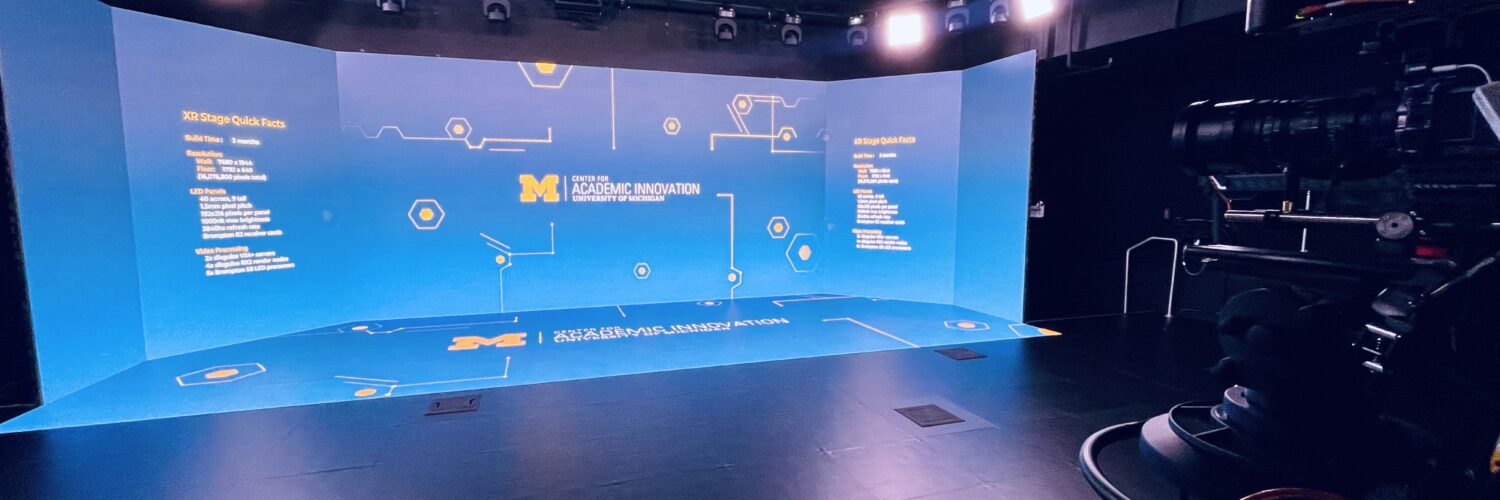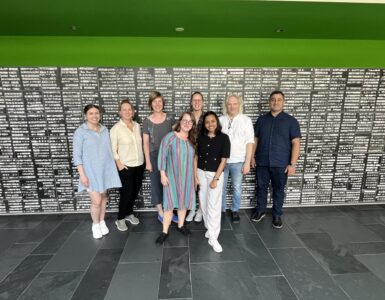by Jeremy Nelson, University of Michigan, USA.
At the heart of the University of Michigan’s campus of more than 50,000 students lies a new technology changing how we think about online and hybrid education. The new Extended Reality (XR) Studio, established by the Center for Academic Innovation (CAI), is not just a space but a gateway to new dimensions of learning. This state-of-the-art facility allows instructors to transport learners across time and space—from ancient cities to subatomic particles—all accessible via their digital devices.
The concept of the XR Studio was inspired by the innovative use of technology in the entertainment industry, notably the production techniques used in the Disney+ series “The Mandalorian.” CAI is one of the primary drivers of online education at the University of Michigan and in the summer of 2023, they moved into a new building with six state-of-the-art production studios. The XR studio utilizes large LED screens and advanced camera tracking to create immersive 3D environments where faculty are fully immersed in a digitally rendered world. This method significantly reduces the need for post-production, allowing for real-time learning experiences that are both dynamic and interactive.
Eric Schreffler, an XR developer at the center, described the studio as a blend of Hollywood magic and educational rigor. “It’s like having a bit of Hollywood here in Ann Arbor,” said Schreffler. He works from the control room, orchestrating immersive sessions that help bridge the gap between theoretical knowledge and practical application.
The technology’s power lies in its ability to make complex subjects more accessible and engaging. Jonathan Rule, a clinical assistant professor of architecture and urban planning, uses the XR stage to teach construction and design. “My aim is to make learning hands-on, even if it’s virtual,” Rule said. “Students can manipulate objects, see how structures come together, and truly understand the mechanics behind what they’re studying.”
The center has created hundreds of Massive Open Online Courses (MOOCs) and online degree programs for the University of Michigan since 2014. Over the last 10 years, more than 275 courses and 11.1 million people have enrolled in these courses from every country in the world. This XR studio will act as a catalyst to help explore and innovate on what online learning will look like in the next 10 years. This studio was born out of the work of the XR Initiative at the university and builds on the experience of creating AR and VR applications for 30 faculty from 17 of the 19 schools and colleges at U-M.
As the studio evolves, it is set to impact a wide range of disciplines at the university. Currently, there are three online courses in production using the studio.
A mindful leadership course taught by Ram Mahalingam of Michigan LSA will use immersive environments to assist in meditation.
Cinedum Okwudire of Michigan Engineering will teach a course that explores how to print metal objects with 3D printers and will use AR objects and virtual backgrounds to showcase the printers and created objects.
Finally, Chase Cantrell of the Taubman School of Architecture will lead a course that explores the before-and-after environments of communities that rehabilitate their urban neighborhoods. The XR Studio’s versatility makes it a valuable tool for faculty across the university looking to innovate how their subjects are taught.
The technology powering the XR Studio is a blend of cutting-edge systems designed to create a seamless and immersive learning environment. Central to its operation is an automated lighting control system, which adjusts the lighting dynamically to enhance the visual fidelity of virtual productions. This is complemented by Stype camera tracking, which accurately captures the movement of cameras in real time, ensuring that virtual and real elements align perfectly. The studio also utilizes Red Komodo cameras, renowned for their high-resolution output and color fidelity, essential for creating lifelike virtual experiences. At the heart of the studio’s technological suite is the Disguise media server. This robust platform supports various media types, from 2D images and videos to immersive 360-degree videos, as well as real-time environments rendered in Unreal Engine, allowing educators to craft detailed and interactive virtual landscapes.
Our work in XR exemplifies the university’s commitment to leading the way in educational innovation, ensuring that learning is not just about receiving information but a rich, interactive experience. As the center continues to push the boundaries of what’s possible in education, the XR Studio stands as a testament to the potential of technology to transform learning landscapes not just at U-M but around the world.

Author
Jeremy Nelson, Senior Director of XR, Media Design & Production, University of Michigan, USA













